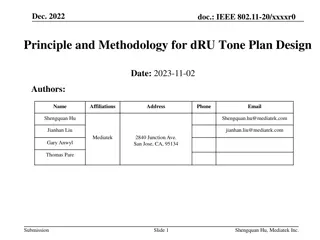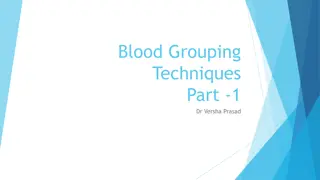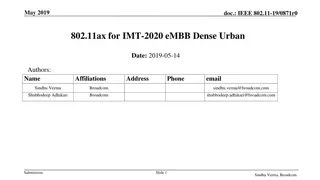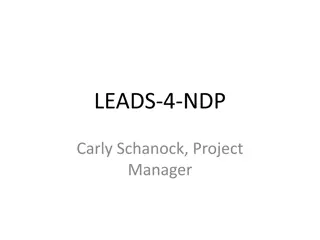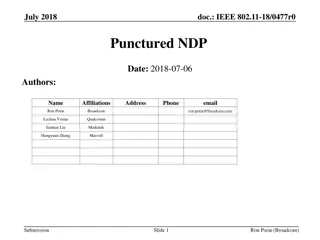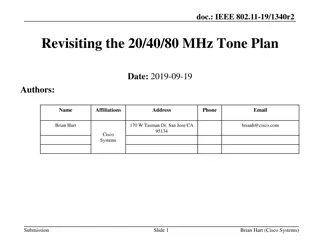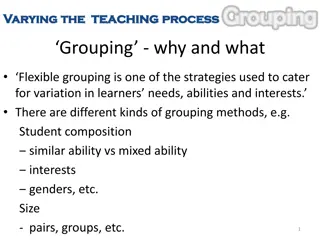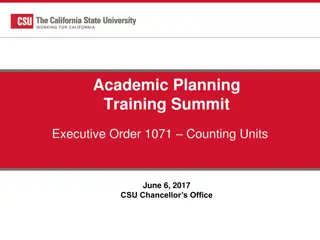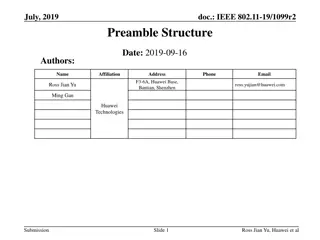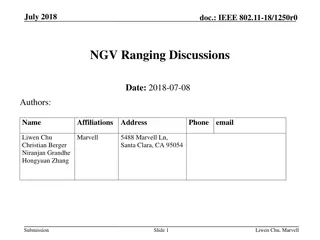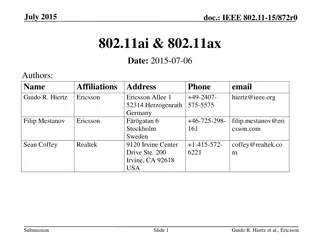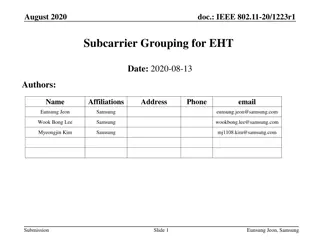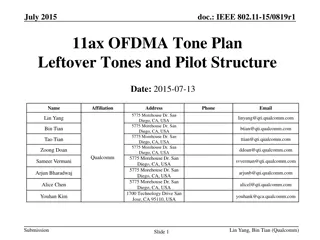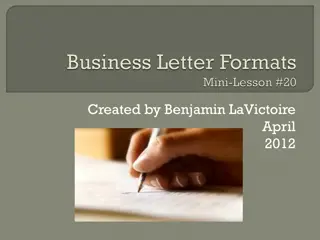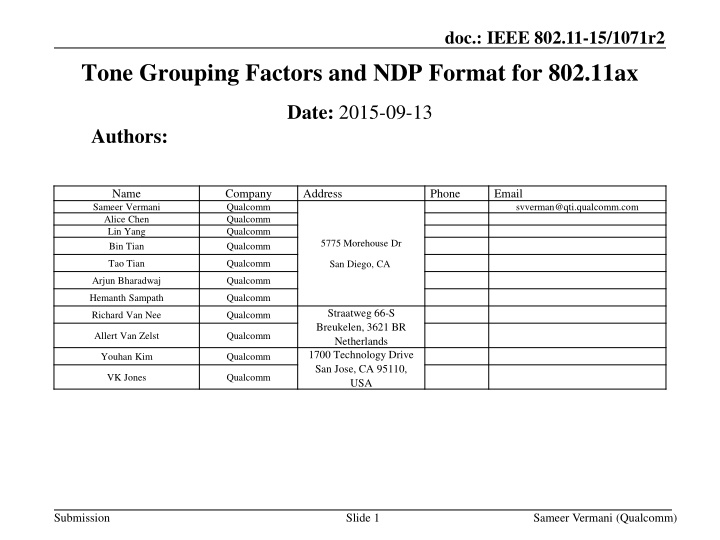
IEEE 802.11-15 Study on Tone Grouping Factors and NDP Format for 802.11ax
Explore the detailed discussion from the document IEEE 802.11-15/1071r2 regarding tone grouping factors and NDP format for the development of 802.11ax. The document features contributions from multiple authors representing leading technology companies. Gain insights into the technical aspects and considerations for this advancement in wireless communication technology.
Download Presentation

Please find below an Image/Link to download the presentation.
The content on the website is provided AS IS for your information and personal use only. It may not be sold, licensed, or shared on other websites without obtaining consent from the author. If you encounter any issues during the download, it is possible that the publisher has removed the file from their server.
You are allowed to download the files provided on this website for personal or commercial use, subject to the condition that they are used lawfully. All files are the property of their respective owners.
The content on the website is provided AS IS for your information and personal use only. It may not be sold, licensed, or shared on other websites without obtaining consent from the author.
E N D
Presentation Transcript
doc.: IEEE 802.11-15/1071r2 Tone Grouping Factors and NDP Format for 802.11ax Date: 2015-09-13 Authors: Name Company Qualcomm Qualcomm Qualcomm Qualcomm Address Phone Email Sameer Vermani Alice Chen Lin Yang Bin Tian svverman@qti.qualcomm.com 5775 Morehouse Dr Tao Tian Qualcomm San Diego, CA Arjun Bharadwaj Qualcomm Hemanth Sampath Qualcomm Straatweg 66-S Breukelen, 3621 BR Netherlands 1700 Technology Drive San Jose, CA 95110, USA Richard Van Nee Qualcomm Allert Van Zelst Qualcomm Youhan Kim Qualcomm VK Jones Qualcomm Submission Slide 1 Sameer Vermani (Qualcomm)
doc.: IEEE 802.11-15/1071r2 Authors (continued) Name Affiliation Address Phone Email Qinghua Li quinghua.li@intel.com Xiaogang Chen xiaogang.c.chen@intel.com 2111 NE 25th Ave, Hillsboro OR 97124, USA Robert Stacey robert.stacey@intel.com +1-408-765-9698 Intel Po-Kai Huang po-kai.huang@intel.com Chitto Ghosh chittabrata.ghosh@intel.com Rongzhen Yang rongzhen.yang@intel.com Hongyuan Zhang hongyuan@marvell.com Yakun Sun yakunsun@marvell.com Lei Wang Leileiw@marvell.com 5488 Marvell Lane, Santa Clara, CA, 95054 Liwen Chu Marvell +408-222-2500 liwenchu@marvell.com Jinjing Jiang jinjing@marvell.com Yan Zhang yzhang@marvell.com Rui Cao ruicao@marvell.com Submission Slide 2 Sameer Vermani (Qualcomm)
doc.: IEEE 802.11-15/1071r2 Authors (continued) Name Affiliation Address Phone Email Sudhir Srinivasa sudhirs@marvell.com Saga Tamhane sagar@marvell.com Marvell (Cont d) 5488 Marvell Lane, Santa Clara, CA, 95054 Mao Yu 408-222-2500 my@marvel..com Edward Au edwardau@marvell.com Hui-Ling Lou hlou@marvell.com Ron Porat rporat@broadcom.com Matthew Fischer Sriram Venkateswaran Tu Nguyen mfischer@broadcom.com Broadcom Vinko Erceg Brian Hart brianh@cisco.com 170 W Tasman Dr, San Jose, CA 95134 Cisco Systems Pooya Monajemi pmonajem@cisco.com Submission Sameer Vermani (Qualcomm) Slide 3
doc.: IEEE 802.11-15/1071r2 Authors (continued) Name Affiliation Address Phone Email Kiseon Ryu kiseon.ryu@lge.com Jinyoung Chun jiny.chun@lge.com Jinsoo Choi js.choi@lge.com Jeongki Kim jeongki.kim@lge.com 19, Yangjae-daero 11gil, Seocho-gu, Seoul 137- 130, Korea Giwon Park LG Electronics giwon.park@lge.com Dongguk Lim dongguk.lim@lge.com Suhwook Kim suhwook.kim@lge.com Eunsung Park esung.park@lge.com HanGyu Cho hg.cho@lge.com Thomas Derham Orange thomas.derham@orange.com Submission Sameer Vermani (Qualcomm) Slide 4
doc.: IEEE 802.11-15/1071r2 Authors (continued) Name Affiliation Address Innovation Park, Cambridge CB4 0DS (U.K.) Maetan 3-dong; Yongtong-Gu Suwon; South Korea 1301, E. Lookout Dr, Richardson TX 75070 Innovation Park, Cambridge CB4 0DS (U.K.) 1301, E. Lookout Dr, Richardson TX 75070 Maetan 3-dong; Yongtong-Gu Suwon; South Korea Phone Email Fei Tong f.tong@samsung.com +44 1223 434633 Hyunjeong Kang hyunjeong.kang@samsung.com +82-31-279-9028 Kaushik Josiam k.josiam@samsung.com (972) 761 7437 Samsung Mark Rison m.rison@samsung.com +44 1223 434600 Rakesh Taori rakesh.taori@samsung.com (972) 761 7470 Sanghyun Chang s29.chang@samsung.com +82-10-8864-1751 Yasushi Takatori takatori.yasushi@lab.ntt.co.jp Yasuhiko Inoue inoue.yasuhiko@lab.ntt.co.jp 1-1 Hikari-no-oka, Yokosuka, Kanagawa 239-0847 Japan Yusuke Asai NTT asai.yusuke@lab.ntt.co.jp Koichi Ishihara ishihara.koichi@lab.ntt.co.jp Akira Kishida kishida.akira@lab.ntt.co.jp 3-6, Hikarinooka, Yokosuka- shi, Kanagawa, 239-8536, Japan Akira Yamada yamadaakira@nttdocomo.com watanabe@docomoinnovations. com hpapadopoulos@docomoinnova tions.com Fujio Watanabe NTT DOCOMO 3240 Hillview Ave, Palo Alto, CA 94304 Haralabos Papadopoulos Submission Sameer Vermani (Qualcomm) Slide 5
doc.: IEEE 802.11-15/1071r2 Authors (continued) Name Affiliation Address Phone Email pbarber@broadbandmobilete ch.com peterloc@iwirelesstech.com Phillip Barber The Lone Star State, TX Peter Loc F1-17, Huawei Base, Bantian, Shenzhen 5B-N8, No.2222 Xinjinqiao Road, Pudong, Shanghai F1-17, Huawei Base, Bantian, Shenzhen 5B-N8, No.2222 Xinjinqiao Road, Pudong, Shanghai 5B-N8, No.2222 Xinjinqiao Road, Pudong, Shanghai 10180 Telesis Court, Suite 365, San Diego, CA 92121 NA 303 Terry Fox, Suite 400 Kanata, Ottawa, Canada F1-17, Huawei Base, Bantian, Shenzhen 10180 Telesis Court, Suite 365, San Diego, CA 92121 NA F1-17, Huawei Base, Bantian, SHenzhen 303 Terry Fox, Suite 400 Kanata, Ottawa, Canada 5B-N8, No.2222 Xinjinqiao Road, Pudong, Shanghai Le Liu liule@huawei.com +86-18601656691 Jun Luo jun.l@huawei.com Yi Luo Roy.luoyi@huawei.com +86-18665891036 Yingpei Lin linyingpei@huawei.com Jiyong Pang pangjiyong@huawei.com Huawei Zhigang Rong zhigang.rong@huawei.com Rob Sun Rob.Sun@huawei.com David X. Yang david.yangxun@huawei.com Yunsong Yang yangyunsong@huawei.com Zhou Lan Lanzhou1@huawei.com +86-18565826350 Junghoon Suh Junghoon.Suh@huawei.com Jiayin Zhang zhangjiayin@huawei.com +86-18601656691 Submission Sameer Vermani (Qualcomm) Slide 6
doc.: IEEE 802.11-15/1071r2 Authors (continued) Name Affiliation Address Phone Email No. 1 Dusing 1st Road, Hsinchu, Taiwan James Yee +886-3-567-0766 james.yee@mediatek.com Alan Jauh alan.jauh@mediatek.com chinghwa.yu@mediatek.co m frank.hsu@mediatek.com Mediatek Chingwa Hu Frank Hsu 2860 Junction Ave, San Jose, CA 95134, USA Thomas Pare +1-408-526-1899 thomas.pare@mediatek.com chaochun.wang@mediatek.c om james.wang@mediatek.com ChaoChun Wang James Wang Mediatek USA Jianhan Liu Jianhan.Liu@mediatek.com Tianyu Wu tianyu.wu@mediatek.com russell.huang@mediatek.co m ericwong@apple.com Russell Huang Eric Wong +1-408-9745967 Chris Hartman Cupertino, CA Aon Mujtaba Apple Joonsuk Kim joonsuk@apple.com Guoqing Li +1-408-974-9164 guoqing_li@apple.com Submission Sameer Vermani (Qualcomm) Slide 7
doc.: IEEE 802.11-15/1071r2 Authors (continued) Name Affiliation Address Phone Email Weimin Xing Xing.weimin@zte.com.c n Kaiying Lv lv.kaiying@zte.com.cn ZTE Corp. Ke Yao Yao.ke@zte.com.cn Bo Sun Sun.bo1@zte.com.cn Yonggang Fang ZTE TX yfang@ztetx.com Kazuyuki.Sakoda@am.son y.com Kazuyuki Sakoda YusukeC.Tanaka@jp.sony.c om Yusuke Tanaka Sony Eisuke.Sakai@jp.sony.com Eisuke Sakai Electronics Yuichi.Morioka@jp.sony.co m Yuichi Morioka Masahito.Mori@jp.sony.co m Masahito Mori Submission Sameer Vermani (Qualcomm) Slide 8
doc.: IEEE 802.11-15/1071r2 Introduction In these slides, we cover the following two topics Tone grouping factors for CSI feedback Show simulations for MU-MIMO performance NDP Frame Format Propose the following Disallow Ng=1 feedback in 802.11ax Use the SU frame format for HE-NDP Terminology: In these slides, tone grouping factor is always defined with respect to data tones of the 11ax PPDU (regardless of the LTF duration used in NDP or data packet) E.g., Ng=4 in 11ax means 1 out of every 4 data tones of 11ax packet Submission Slide 9 Sameer Vermani (Qualcomm)
doc.: IEEE 802.11-15/1071r2 Tone Grouping Factors In 802.11ac, the process of sub-sampling the CSI feedback is called tone-grouping Sending one value of V or one value of S for a group of tones E.g. Tone grouping factor, Ng =2 means that one V is sent for a group of 2 tones Once Ng has been chosen, Ng = 2* Ng is the tone-grouping factor used for S Ng=1 feedback in 11ax would be prohibitively expensive Would be approximately 4 times in size compared to Ng=1 feedback in 11ac Tones in 11ax are 4 times thinner Based on our results, even Ng=4 for 11ax works for indoor channels Will show simulation results in subsequent slides Suggest restricting Ng to be greater than equal to 2 for 11ax Ng=4 works well for most practical scenarios where MU-MIMO will be used Ng=2 might have some use for outdoor channels Submission Slide 10 Sameer Vermani (Qualcomm)
doc.: IEEE 802.11-15/1071r2 Simulations for Tone-grouping Factors Compared the 20MHz DL MU-MIMO performance with various options Tone-grouping factor, Ng=1 and 4 LTF durations used in NDP 4x when Ng=1, and 1x when Ng=4 1x LTFs in NDP have two options VHT-LTF with 56 tones HE-1x-LTF: A modified VHT-LTF with more edge tones leading to total 60 tones Tried both 2x and 4x LTFs in DL MU-MIMO data packet Minimal performance difference for indoor channels Show that Ng=4 with 1x LTFs in NDP (and no edge tone augmentation) has good performance for indoor channels Similar performance as Ng=1 with 4x LTFs in NDP Assumed simple linear interpolation at the AP and phase alignment of V Simulated both channel models D-NLOS and E-NLOS Submission Slide 11 Sameer Vermani (Qualcomm)
doc.: IEEE 802.11-15/1071r2 Simulation Assumptions Considered a 20MHz DL MU-MIMO system with 8 Tx AP, and 3 STAs with 2 Rx antennas each, 2 streams per STA MMSE precoding done at the AP Capacity averaged post processing SINRs mapped to PHY throughputs using AWGN rate table Plot the 10th percentile and 50th percentile PHY throughputs for 200 channel realizations of D-NLOS/E-NLOS as a function of path-loss Sum PHY throughput at the AP Aging Loss = -30 dBc Tx Distortion = -35 dBc Channel estimation loss is considered both in sounding and in actual data transmission No quantization is considered to isolate the impact of interpolations No smoothing at the STA is assumed Submission Slide 12 Sameer Vermani (Qualcomm)
doc.: IEEE 802.11-15/1071r2 Simulation Results: D-NLOS Ng=4 feedback with 1x LTFs in NDP shows some smoothing gain compared to Ng=1 with 4x LTFs in NDP In reality Ng=1 can also benefit from smoothing Nevertheless, these results give confidence in Ng=4 with 1x LTFs in NDP Submission Slide 13 Sameer Vermani (Qualcomm)
doc.: IEEE 802.11-15/1071r2 Simulation Results: E-NLOS Ng=4 feedback with 1x LTFs in NDP shows some smoothing gain compared to Ng=1 with 4x LTFs in NDP In reality Ng=1 can also benefit from smoothing Nevertheless, these results give confidence in Ng=4 with 1x LTFs in NDP Submission Slide 14 Sameer Vermani (Qualcomm)
doc.: IEEE 802.11-15/1071r2 HE-NDP HE-NDP is needed to cover outdoor use-case May allow multiple HE-LTF durations in an HE-NDP A subset of 1x, 2x and 4x LTFs may be allowed Re-use the SU frame format for the HE-NDP HE-SIG-B is not needed May need some packet extension at the end Packet Extension HE-SIG-A RL-SIG HE-STF HE-LTFs L-STF L-LTF L-SIG Format of HE-NDP Submission Slide 15 Sameer Vermani (Qualcomm)
doc.: IEEE 802.11-15/1071r2 Summary Ng=1 feedback is very expensive for 11ax Has 4 times overhead when compared to the Ng=1 feedback of 11ac Showed simulations to show that Ng=4 in 11ax gives satisfactory performance in indoor channels for MU-MIMO Suggest disallowing Ng=1 sounding feedback in 802.11ax Also recommend to use the SU frame format for HE-NDP Submission Slide 16 Sameer Vermani (Qualcomm)
doc.: IEEE 802.11-15/1071r2 Straw-poll 1 Do you agree to add the following text to the TGax spec framework document: 802.11ax spec shall not support Ng=1 for sounding feedback. Note that the tone grouping factor, Ng is defined with respect to data tones of the 11ax PPDU. Y N A Submission Slide 17 Sameer Vermani (Qualcomm)
doc.: IEEE 802.11-15/1071r2 Straw-poll 2 Do you support to add the following text and diagram to the SFD The spec shall define an HE-NDP for collecting sounding feedback, whose frame format is shown in the diagram below. The presence and duration of packet extension at the end of HE-NDP is TBD. Packet Extension HE-SIG-A RL-SIG HE-STF HE-LTFs L-STF L-LTF L-SIG Format of HE-NDP Submission Slide 18 Sameer Vermani (Qualcomm)
doc.: IEEE 802.11-15/1071r2 Motion 1 Move to add the following text to the TGax spec framework document: 802.11ax spec shall not support Ng=1 for sounding feedback. Note that the tone grouping factor, Ng is defined with respect to data tones of the 11ax PPDU. Submission Slide 19 Sameer Vermani (Qualcomm)
doc.: IEEE 802.11-15/1071r2 Motion 2 Move to add the following text and diagram to the SFD The spec shall define an HE-NDP for collecting sounding feedback, whose frame format is shown in the diagram below. The presence and duration of packet extension at the end of HE-NDP is TBD. Packet Extension HE-SIG-A RL-SIG HE-STF HE-LTFs L-STF L-LTF L-SIG Format of HE-NDP Submission Slide 20 Sameer Vermani (Qualcomm)

